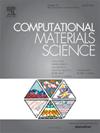Investigating the temperature and Al doping effect on the O2 adsorption Process on ZnO nanowire surface: A ReaxFF-MD approach
IF 3.3
3区 材料科学
Q2 MATERIALS SCIENCE, MULTIDISCIPLINARY
引用次数: 0
Abstract
ZnO nanostructures have garnered significant attention from researchers and industries due to their outstanding properties as gas-sensing materials. Aluminium (Al) doping, in particular, can further fine-tune or optimize these gas-sensing properties. In this research, we investigate the adsorption of O2 molecules on undoped and Al-doped ZnO nanowires at and doping concentrations using advanced reactive force field (ReaxFF)-based molecular dynamics (MD) simulations. The adsorption process is studied at temperatures of 100 K, 300 K, and 500 K, with 300 O2 molecules in each case, and the influences of these factors on the adsorption type are analyzed through radial distribution function (RDF) analysis. The adsorption behavior of O2 molecules on both undoped and Al-doped ZnO nanowires is compared by calculating system energy, adsorption energy, and the number of adsorbed molecules. The results show that the binding distances between O2 molecules and Zn and Al atoms on the nanowire surfaces are 2.18 Å and 1.78 Å, respectively, as determined from RDF analysis. The O2 adsorption process on undoped and Al-doped ZnO nanowire surfaces occurs in two distinct stages, with higher temperatures leading to an increased number of adsorbed molecules. As Al doping increases, it significantly accelerates O2 adsorption in the initial stage, while pure ZnO shows greater adsorption number in the second stage. Chemisorption dominates the interaction in both undoped and Al-doped ZnO.

温度和Al掺杂对ZnO纳米线表面O2吸附过程的影响:ReaxFF-MD方法
ZnO纳米结构由于其优异的气敏材料性能而引起了研究人员和工业界的极大关注。特别是铝(Al)掺杂可以进一步微调或优化这些气敏性能。在这项研究中,我们利用先进的反应力场(ReaxFF)为基础的分子动力学(MD)模拟研究了在掺杂浓度为5%和10%的情况下,O2分子在未掺杂和al掺杂ZnO纳米线上的吸附。分别在100k、300k和500k条件下研究了300个O2分子的吸附过程,并通过径向分布函数(RDF)分析了这些因素对吸附类型的影响。通过计算系统能、吸附能和吸附分子数,比较了O2分子在未掺杂和掺杂al的ZnO纳米线上的吸附行为。结果表明,通过RDF分析,O2分子与纳米线表面Zn和Al原子的结合距离分别为2.18 Å和1.78 Å。氧在未掺杂和掺铝ZnO纳米线表面的吸附过程分为两个不同的阶段,温度越高,吸附分子数量越多。随着Al掺杂量的增加,在初始阶段O2的吸附速度明显加快,而纯ZnO在第二阶段的吸附量更大。在未掺杂和al掺杂的ZnO中,化学吸附是主要的相互作用。
本文章由计算机程序翻译,如有差异,请以英文原文为准。
求助全文
约1分钟内获得全文
求助全文
来源期刊

Computational Materials Science
工程技术-材料科学:综合
CiteScore
6.50
自引率
6.10%
发文量
665
审稿时长
26 days
期刊介绍:
The goal of Computational Materials Science is to report on results that provide new or unique insights into, or significantly expand our understanding of, the properties of materials or phenomena associated with their design, synthesis, processing, characterization, and utilization. To be relevant to the journal, the results should be applied or applicable to specific material systems that are discussed within the submission.
 求助内容:
求助内容: 应助结果提醒方式:
应助结果提醒方式:


